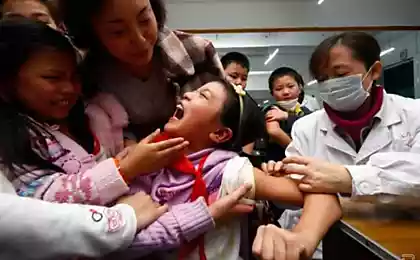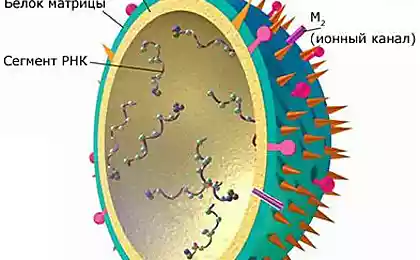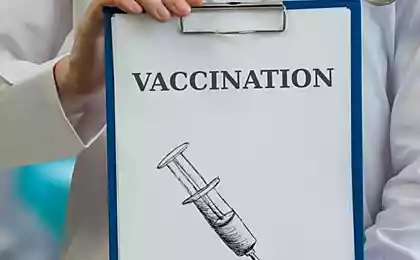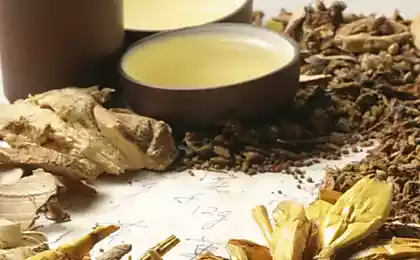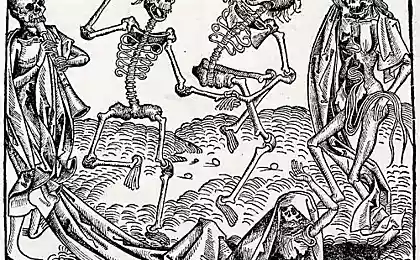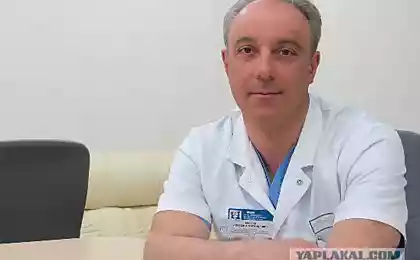921
Are the most popular flu medication?

photo: www.flickr.com every year the residents of Russia spend more than 29.5 billion rubles on drugs for colds and flu. Examining the quality and history 13 the best selling products, Slon found that some of them ease the symptoms of a cold, the rest of the "unique invention of Russian scientists" and does not have proven efficacy. 1. ARBIDOL. Sales volume is 5 billion rubles
2. A couple of days. Sales volume of 3.8 billion rubles
3. ANAFERON. Sales volume of 3.5 billion rubles.
4. OSCILLOCOCCINUM. Sales — 2.6 billion rubles
5. KAGOCEL. Sales — 2.6 billion rubles
6. COLDREX. The sales amount to 1.4 billion rubles
7. ANTIGRIPPIN. The sales amount to 1.4 billion rubles
8. FERVEX. The sales amount to 1.1 billion rubles
9. AMIKSIN. The sales amount to 1.1 billion rubles
10.INGAVIRIN. Sales of 885 million rubles
11. VIFERON
12. ANIMAX
13. GRIPPFERON
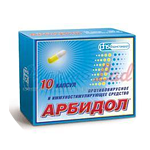
Arbidol
According to the instructions, "antiviral drug"
Sales in 2012: 5,015 billion.
History and manufacturer:
Arbidol was patented in 1974 by a group of Russian scientists from the three institutions. The development was done by order of the military, so the fate of the invention and of its effectiveness there was no information.
Industrial production of "Arbidol" was started in 1992 by Association "moschimpharmpreparaty". In 2001 the company "Masterlek", created by entrepreneurs Alexander Shuster and Vitaly Martyanov, bought the patent for the production of "Arbidol". They soon raised the price of the drug from 20 rubles to 120 rubles, and launched an advertising campaign on television. During the first year of sales of the drug have quadrupled.
In 2003, the company "Profit-house", ruled the assets of Roman Abramovich, has acquired five plants in Russia of the American Corporation ICN Pharmaceutical and several independent companies. Later a management "the Profit house", headed by Victor Haritonin bought shares of "Pharmstandard". In 2006, Schuster and Martyanov sold "Masterlek" the leader of the Russian market of medicines – "Pharmstandard", which lacked a flagship product. They became "Arbidol".
Shortly after the advertising campaign was joined by the head of health Minister Tatyana Golikova and the chief sanitary doctor of Russia Gennady Onishchenko, recommending "Arbidol" for the treatment of influenza. In 2009, during the outbreak of swine flu, sales of "Arbidol" jumped by 102%. The climax of the campaign was the report of 2010, in which Vladimir Putin went to the pharmacy and persistently interested, whether in the sale of "Arbidol" and how much. Soon "Arbidol" was in the List of vital and essential drugs (EDL), which guaranteed a large-scale drug procurement in hospitals across the country.
"Pharmstandard" enjoyed the favor of the Ministry of health. About 90 drugs of the 240 items, produced by "Pharmstandard" entered the essential drugs List of the Ministry of health, and foreign competitors were often unable to register in Russia its products, constitute a direct competition to the production of "Pharmstandard". A business partner and relative of Haritonin, Lev Grigoriev headed the largest state-owned holding company Microgen, which produces the vaccine.
"Farmstandart" – the largest industrial farmholding in Russia, revenues in 2011 – 42,65 billion, net profit of 8.78 billion.
The active ingredient and effectiveness
Umifenovir (50 mg) according to the instructions, inhibits the surface viral protein hemagglutinin and prevent influenza virus A and b inside the cell. Paradoxically, these studies of the effectiveness of "Arbidol", conducted in 1970-ies, are still classified. Former Director TSKHLS-vnikhfi Robert Glushkov willingly paints his dignity: "Antiviral activity, stimulation of immune system, antioxidant", but research data does not.
Pavel Vorobiev, who worked in the early 2000-ies in the Formulary Committee of the Ministry of health, was one of the few who saw the research results of "Arbidol". "We made three investigations of the seven, – said Vorobyov. – It turned out that studies of very low quality and do not prove efficacy. After we told it to the producer of "Arbidol", our collaboration was interrupted".
In the international medical database of scientific publications Medline contains 77 publications devoted to testing "Arbidol", but their results are not unambiguous. On the website of the drug indicated that the use of "Arbidol" leads to a reduction in the average duration of disease was 1.7–2.65 day, and duration of symptoms such as fever, intoxication, runny nose, 1.3–2.3 days. American management under the quality control of drugs and products refused to register "Arbidol".
Distribution
Mainly Russia. In Ukraine "Arbidol" sold under the name "Immolat", in Belarus – "Acetal" in China, it produces a small pharmaceutical company Nanjing Gemsen. In 2007 expired patent for "Arbidol", and now it can release any manufacturer. Wishing, however, a little bit.
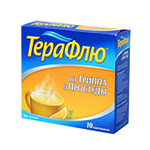
Theraflu
Drug for symptomatic therapy
Sales in 2012: 3,83 billion
History and manufacturer
Combined agent-based paracetamol, eliminating the symptoms of SARS and influenza. Belongs to the Swiss company Novartis, in Canada, manufactured under the brand name NeoCitran in the US and Europe – Theraflu. Paracetamol has been tried on patients pharmacologist Joseph von Mering in 1886. Novartis International is the second largest pharmaceutical manufacturer in the world, turnover in 2012 amounted to $56.7 billion.
The active ingredient and effectiveness
The drug effectively eliminates symptoms of the common cold, but not fights the virus.
– Paracetamol (325 mg) – the main component, reduces fever, anesthetic and constricts blood vessels. The contents of paracetamol in the standard package, "Theraflu" of 10 bags that are sold in drugstores for 300 rubles less than in conventional packaging of paracetamol cost 5 rubles (see table).
– Feniramina maleate (20 mg), an antihistamine, eliminates puffiness.
– Fenilafrina hydrochloride (10 mg) constricts blood vessels of the nose, eliminates swelling of the mucous membranes of the nasopharynx.
– Ascorbic acid (50 mg), or vitamin C – it is considered that increases the body's resistance to infections. This misconception is refuted in numerous studies in recent years

Anaferon
Homeopathic remedy
Sales in the winter season 2011\2012: 2,52 billion rubles.
History and manufacturer
The most telling case of the Russian pharmaceutical market. In 1992, doctor Oleg Epstein, who treated alcoholism by the method of Dovzhenko in Khanty-Mansiysk, Valeriy Naraikin, who led the state pharmacies in the Chelyabinsk region, created the company "Materia Medica holding" manufacturing drugs invented at Tomsk research Institute of pharmacology. On the website of the Institute in the section "Development" listed the whole range "Materia Medica", as well as more than 70 types of biologically active additives (dietary Supplements). Some time shareholder "Materia Medica" was President of the Institute of international law and Economics named after A. S. Griboedov Michael Ilchikov.
One of the first drugs "Materia Medica" was "Anaferon". He quickly got in the EDL that has been sold in all pharmacies and recommended for procurement. At the end of 2011, however, he is excluded from the essential drugs list at the request of the manufacturer, says Epstein. The fact that the EDL recorded the selling price of the drug, which has not changed for several years, "the company had to suffer losses".
However, with the exception of "Anaferon" on the VED List has not led to a reduction in the volume of public procurement, much of which passes through the compulsory medical insurance Fund, and the Secretary of the competitive Commission in this Department is Michael Dygai, the son of the inventor of "Anaferon" by Alexander DIGA.
In 2006 and 2007, inventors of "Anaferon" has received the prize of the government of the Russian Federation in the field of science and technology for development, implementation in production and medical practice of new highly effective medicinal preparations.
"Materia Medica holding" ranked sixth by volume among Russian pharmaceutical companies. The basic brands – "Proproten-100", "Impaza", "TenTen".
Turnover in 2011 – 3.6 billion rubles, net profit of 628 million rubles.
The active ingredient and effectiveness
According to the instructions, is a purified antibodies that precipitate from serum of rabbits immunized with recombinant gamma-interferon person. However, as is homeopathy, the antibodies multiply divorced aqueous-alcoholic solvent, so that the active substance in the tablet contains no more than 10-15 nanograms/gram. Simply put, a hundred millions of pills you can find not more than one molecule of the active ingredient.
Registered as "drugs that activate antiviral immunity". According to the manufacturer, the prophylactic and therapeutic acceptance of child "Anaferon" by half reduces the incidence of influenza, more than half of the children removes the heat on the second day of the flu, 2.3 times reduces the frequency of bacterial complications (otitis, sinusitis).
In the international medical database Medline contains 18 papers devoted to tests of "Anaferon", but all of them were conducted in Russia and Ukraine, in the majority of cases with participation of Oleg Epstein and other staff "Materia Medica".
According to Epstein, the initial testing of the drug took place in the hospital in the town of Volsk in the Saratov region, and then at the Novosibirsk center "Vector", the clinic of the research Institute of influenza. However, the Director of Institute of influenza Oleg Kiselyov in interview to TV channel "Rain" to the question about the drug answered unambiguously: "Anaferon" I drive across the country, and not driven out. I am now preparing a letter to [the health Minister] Skvortsova, to restore order in the market. Because even the idea [of the drug] is just a fraud."
Distribution
Russia, Ukraine, Belarus, Kazakhstan, Kyrgyzstan, Moldova, Uzbekistan, Georgia, Armenia, Turkmenistan, Tajikistan and Azerbaijan.
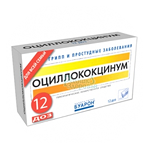
Oscillococcinum
Homeopathic medicine
Sales in 2012 to 2.65 billion rubles
History and manufacturer
"Oscillococcinum" was invented in 1925 by the French physician Joseph Roy, who spotted some bacteria in the blood of patients with flu, herpes, tuberculosis, rheumatism, cancer. Mystic microbes he called Oscillococcus. Medical science has refuted the theory of ROI, he simply could not see in the optical microscope the viruses. "Vaccine", which was created by Roy from the extract iilogical, was completely ineffective.
Nevertheless, Roy found the same bacteria in the liver of musk ducks with long island, which began to prepare a homeopathic remedy. In 2011 the company "Boiron", a lawsuit was filed on behalf of "all California residents who purchased "Oscillococcinum" in the last four years." The claim "Boiron" accused of false statement that "Oscillococcinum" can cure the flu. In fact the active ingredient of the drug has no proven medicinal qualities. The parties entered into a plea agreement.
"Laboratory Boiron" – the world's largest manufacturer of homeopathic medicines with headquarters in France. Turnover in 2011 – 523 million euros.
The active ingredient and effectiveness
Anas Barbariae Hepatis et Cordis Extractum – extract of heart and liver of Barbary duck – 200СК in 1 dose. Barbary duck Anas Barbariae not exist in nature. Moreover, the concentration of the 200CK indicates that the preparation of tablet was done 200 dilutions in the ratio of 1:100 of the original extract of liver and heart of a duck. Concentration of the original extract per dose is so small that eliminates the presence of at least one molecule of the active ingredient in all been done "by the Laboratory Boiron" the pellets together.
The representative of the "Boiron Laboratories" Gina Casey a question about the danger of eating of the extract of heart and liver of a duck said that "Oscillococcinum", of course, is safe, there's nothing out there".
The results of seven clinical trials, involving 3459 patients, did not confirm the preventive effectiveness of the "Oscillococcinum" and similar homeopathic remedies against influenza.
At the end of 2012 mokranowski the British society of evidence-based medicine published a report denying the effectiveness of "Oscillococcinum".
Distribution
Sold in more than 50 countries, it is especially popular in France, is the most sold in the country are non-prescription remedy for influenza.

Kagocel
According to the instructions, "antiviral and immunomodulatory drug"
Sales in 2012: 2,64 billion
History and manufacturer
Developed by academician of RAMS, Director of scientific research Institute of epidemiology and Microbiology named after N. F. Gamalei Felix Ershov, head of the division of immunology of the Institute Vladimir Nesterenko. In 2005 the company "nearmedic plus", Nesterenko established in 1989, began manufacturing "Kagotsel" as over-the-counter drug.
Since 2010, "Kagocel" included in the essential drugs List. After that, the Minister of health Tatyana Golikova held with journalists RAID the pharmacies of Moscow, where in front of television cameras asked pharmacists the presence of "Kagotsel".
In February 2012, "nearmedic plus" together with state Corporation "Rosnano" has created the company "nearmedic Pharma" for building their own pharmaceuticals plant in Kaluga region, worth 4 billion rubles.
The revenue of "nearmedic plus" in 2011, 1.9 billion rubles. Net profit of 87 million roubles. Nesterenko also owns a chain of medical centers "nearmedic plus" company "Biofarmakholding", which is engaged in the production of reagents for medical research and clinic therapy, using stem cells "modern medicine".
At the end of 2012 against "Kagotsel" began the anonymous PR campaigns, during which it was alleged that the drug allegedly negative impact on the reproductive function of men.
The active substance and effectiveness"Kagocel" (12 mg). Vladimir Nesterenko in an interview, described his invention: "We took cellulose is a polymer made of cotton, took some more substance derived from cotton, combined it with the pulp and the polymer obtained. It is called "Kagotsel".The producers of "Kagotsel" conducted the most extensive clinical studies of all these drugs in them took part more than two thousand people. The majority of studies "Kagocel" conducted and published it themselves inventors Felix Ershov and Vladimir Nesterenko. In studies it was noted that "Kagocel" reduces the incidence of influenza and SARS in 3.4 times.
In the international medical database Medline contains nine publications, all just from Russian magazines.
Distribution
In addition to Russia, "Kagocel" for sale in Ukraine, Belarus, Uzbekistan, Moldova, Armenia and Georgia.
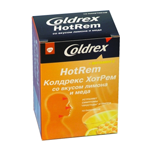
Coldrex
Drug for symptomatic therapy of acute respiratory infections
Sales in 2012:1.47 billion rubles
History and manufacturer
Popular umbrella brand for a group of drugs that relieves the symptoms of colds, owned by British GlaxoSmithKline, third farmholding in the world of sales (after Pfizer and Novartis). Main brands: "Panadol", "Coldrex", "Solpadein", "Augmentin", "Fortum". Revenue in 2011 to $43.4 billion, net profit of $9 billion.
The active ingredient and effectiveness
Is paracetamol – 500 mg reduces fever, stops the pain and constricts blood vessels. The average price for a pack of 10 doses is 240 rubles (pack of 10 tablets of ordinary paracetamol the same concentration – 5 roubles);
– caffeine – 25 mg, stimulates mental and physical performance, decreases drowsiness;
– fenilafrina hydrochloride 5 mg, constricts blood vessels of the nose, eliminates swelling;
– terpin hydrate 20 mg, thins and improves expectoration;
– ascorbic acid – 30 mg, it is assumed that vitamin C increases the body's resistance to infections. This misconception is refuted in numerous studies in recent years.
Effectively eliminates the symptoms, but does not have antiviral activity.
Distribution
Central and Eastern Europe, Hong Kong, New Zealand.
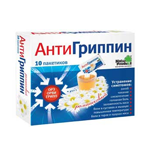
Antigrippin
Drug for symptomatic therapy of acute respiratory infections
Sales in 2012: 1.46 bln rubles
History and manufacturer
Combined analgesic based on paracetamol from the Russian company "Natur Product", founded in 1993 by entrepreneur Sergey Nizovtsev. For the first time "the flu" appeared in pharmacies in the mid 1990-ies, in 2006, "Natur Produkt" registered exclusive trademark rights that contain the word "Antigrippin" and then filed a lawsuit against the company, "Antiviral", which produces the drug under a similar name – "Antigrippin-Maximum". As a result, the court dismissed the claim of "Natures Product" to other producers.
The company specializiruetsya on the production of OTC drugs, ranked fourth on the Russian market of dietary Supplements. In 2009, the owner of the company became the holding company Renova Viktor Vekselberg. In 2012 the company was sold to canadian pharmholding Valeant Pharmaceuticals International. The basic brands – "the flu", "Anti-Angin", "Vita plant".
The active ingredient and effectiveness
Is paracetamol – 500 mg reduces fever, stops the pain and constricts blood vessels. The average price for a pack of 10 doses is 230 rubles (pack of 10 tablets of ordinary paracetamol the same concentration – 5 roubles);
– chlorpheniramine maleate – 10 mg, constricts blood vessels of the nose and eliminates swelling of the mucous membrane of the nasopharynx;
– ascorbic acid – 200 mg, it is assumed that vitamin C increases the body's resistance to infections. This misconception is refuted in numerous studies in recent years.
The drug effectively relieves symptoms, but does not have antiviral activity.
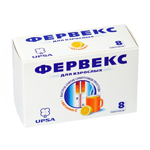
Fervex
Drug for symptomatic therapy of acute respiratory infections
Sales in 2012: 1.18 billion rubles.
History and manufacturer
A popular brand of combined analgesic based on paracetamol, owned by the American company Bristol-Myers Squibb, established in 1989 the merger of Bristol-Myers and Squibb Corporation. Specializiruetsya on the development and manufacture of prescription drugs for the treatment of cancer, HIV/AIDS, cardiovascular diseases, diabetes and others. Revenue in 2011 to $21.24 billion, net income of $3.71 billion
The active ingredient and effectiveness
Is paracetamol – 500 mg reduces fever, stops the pain and constricts blood vessels. The average price for a pack of 8 doses is 270 rubles (pack of 10 tablets of ordinary paracetamol the same concentration – 5 roubles);
– feniramina maleate – 25 mg, has an antihistamine effect, reduces allergic reactions;
– ascorbic acid – 200 mg, it is assumed that vitamin C increases the body's resistance to infections. This misconception is refuted in numerous studies in recent years.
Medication relieves symptoms, but does not fight off the flu virus.
Distribution
Russia, Europe, USA.

Amiksin
According to the instructions, "antiviral and immunomodulatory drug"
Sales volume in 2012, with 1.17 billion rubles
History and manufacturer
The active ingredient tilorona was first patented in 1968 in the US, but he never became a drug because of lack of proof of effect. In the 1970-ies, the substance was re-synthesized in the laboratories of Physico-chemical Institute of the Academy of Sciences of the Ukrainian SSR. In the 1980-ies, there have been several clinical trials tilorona, however, was as a drug for the prevention and treatment of viral infections it was only in 1996.
In the late 1990s – early 2000s were made in the Odessa chemical-pharmaceutical Institute, in 2003 the company "Masterlek" placed an order for the production of "amiksina" Khabarovsk plant "Alpharma" and started an advertising campaign of the drug, thanks to which the sale in five years has grown six-fold. In 2006, "Arbidol" and "Amiksin" was sold to the holding company "Pharmstandard".
The active ingredient and effectiveness
According to the instructions, tilorona (60 mg) is effective against viruses not just flu, but also hepatitis A, and herpes. However, large-scale studies on the effectiveness of "amiksina" outside the former Soviet Union was conducted. In 2001, it conducted the only randomized study of efficacy in influenza and other respiratory viral infections. In children there was a reduction in the duration of symptoms by 2.5 times and decrease the recovery time in half. Results published only in preferirana VAK "Russian medical journal".
Distribution
Russia, Ukraine, Georgia.
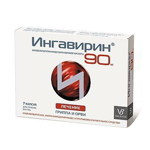
Ingavirin
According to the instructions, "antiviral drug"
Sales volume in 2012, with 885 million rubles
History and manufacturer
In the 1970-ies pulmonologist Alexander Chuchalin has developed a drug to betaglucan, which until 2008 was sold under the brand name "Dicarbonyl" and was used as a stimulant of hematopoiesis in patients receiving anti-cancer therapy.
In 2009, during the hysteria around the swine flu Chuchalin, the main therapist of Russia, remembered his invention and discovered that this drug also can fight the swine flu virus: "antivirus Activity of a preparation "Ingavirin" is much higher than that of the American "Tamiflu". Our product easily integrates into the genome of the H1N1 virus and quickly destroy it. And other dangerous viruses too", – he told in interview to magazine "Spark".
Chuchalin offered his invention to combat swine flu the chief sanitary doctor of Russia Gennady Onishchenko who has promoted the accelerated clinical trials of the drug and registration as a medicine "Ingavirin". A few months after the start of sales of the drug have been recommended by MoH for the treatment of swine flu.
Valenta is among the five largest pharmaceutical companies of Russia, was established in 1997 on the basis of JSC "Shchelkovo vitamin factory". Valenta doesn't disclose its owners. The most famous brands of the company – "Phenotropil", "zoreks", "Phenazepam", "Antigrippin SARS". Revenue "Valenta" in 2011 amounted to 5,18 billion roubles.
The active ingredient and effectiveness
Betaglucan (90 mg). "Ingavirin" appeared in pharmacies in 2008 without a full research. Accelerated clinical trials were conducted on mice and the group of 100 patients. "Application "Ingavirin" in the first 48 hours of illness leads to a significant reduction of the period of fever, intoxication and catarrhal symptoms" – that is the conclusion a group of scientists who conducted the study of medicine under the leadership of its inventor – Alexander chuchalina.
In the international database of scientific publications has 31 articles devoted to the drug, but all of them were written in Russia, and most in collaboration with Cocainum.
Distribution
Russia

Viferon
According to the instructions, "immunomodulator with antiviral effect"
Sales in the winter season 2011\12: 1,82 billion
History and manufacturer
"Viferon" was developed in the years 1990-1995, a group of scientists, Institute of epidemiology and Microbiology them. N. F. Gamalei under the guidance of Professor Valentina Malinovskaya. In the same research Institute the work was carried out at the preclinical pharmacotoxicological the study drug.
In 1996, the Director together with her husband, co-owner of "SDM-Bank" Evgenie Malinovsky, was created LLC "Feron" with production on the basis of scientific research Institute of Virology. The company's revenue in 2011 amounted to 2 billion rubles.
The active ingredient and effectiveness
Interferon Alfa-2b human recombinant 150 000 IU. According to the instructions, the drug stimulates production of interferon in the human body, preventing the infestation of the body by viruses. Again, according to the instructions, "Viferon" can be used for the treatment of herpes, chlamydia and hepatitis. However, outside the countries of the former USSR interferon inducers are not registered as medicines, and in reputable international scientific journals no publications proving their effectiveness.
Clinical studies of "Interferon" was held in six Moscow hospitals and the Institute of Pediatrics Academy of medical Sciences. In most of the studies involved Valentina Malinovskaya, the inventor of the "Viferon" and co-owner of the manufacturer of the medication.
One of the last trials of the drug was carried out in 2008 to the Director and her colleague from the Institute of Virology. D. I. Ivanovsky Lyudmyla Kolobukhina and showed that in the treatment of influenza "Viferon" even more effective than its famous competitor – "Arbidol".
Distribution
Russia

Animax
Drug for symptomatic therapy of acute respiratory infections
Sales in the winter season 2011\12: 1,12 billion roubles
History of the drug and the manufacturer
Previously, the drug was called "Antigrippin-Maximum", it was invented by a group of scientists under the direction of Professor Dmitry Zlydnikov, head of the clinic of the research Institute of influenza of the RAMS. In the 1990's, scientists decided to introduce their project into production and, together with St. Petersburg businessman Evgeny Kupsinel created the company "Antiviral", which is engaged in the production of "the Skin".
In the late 2000s, according to the Director of Institute of influenza Oleg Kiselyov, Kupsin "washed away" a share in the company belonging to research Institute of influenza. In the summer of 2011 Eugene Cupsin sold "Antiviral" one of the largest distributors of medicines in Russia – the group of companies "PROTEK".
In 2009-2012 the company "Natur Product", which in 2009 registered the exclusive right to a trademark "Antigrippin", the beginning of the trials, demanding "Antiviral" remove from names of drugs the word "Antigrippin". Despite the fact that the court refused to satisfy the requirements of "Natural products" in 2011, "Antiviral" was renamed its product, giving it a new name – "Animax".
The active ingredient and effectiveness
– Paracetamol – 360 mg;
– rimantadine hydrochloride 50 mg, a derivative of adamantane, is considered a compound with a moderate antiviral effect;
– ascorbic acid (vitamin C) 300 mg;
– loratadine 3 mg, according to the instructions, warn development and facilitates the allergic reactions;
– rutin – 20 mg, reduces the permeability and fragility of capillaries, prevents bleeding;
– Calcium gluconate monohydrate 100 mg (data on the effectiveness of calcium also repeatedly refuted, as evidence of the effectiveness of vitamin C).
In addition to the standard for such drugs are components that reduce the symptoms of colds, "Antigrippin-Maximum" contains the antiviral agent is rimantadine, whose effectiveness against various strains of influenza A has been proven in 1965. According to the instructions, prophylactic purpose of rimantadine in a daily dose of 200 mg decreases the risk of influenza and reduces the severity of flu symptoms and serological reactions.
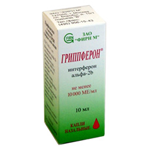
Grippferon
According to the instructions, "immunomodulatory drug with antiviral effect"
Sales in the winter season 2011\12: 1,03 billion roubles
History and manufacturer
In 2000, doctor of medical Sciences, specialist in acupuncture and acupuncture Peter, Gaponyuk patented drug, "Grippferon". Based on the interferon, which was once given to babies at the children's clinic, Gaponik increased concentration, penetration of the drug, and created the technology of preservation of its activity in liquid form. "In the application of "Grippferon" there is no danger of infection by such viruses as AIDS, hepatitis, etc." –said one of the first advertisements of the drug.
Soon, however, Gaponyuk patented separate medication to prevent AIDS. Former Minister of health and social development Tatyana Golikova has repeatedly publicly recommended to use to fight the flu "Arbidol", "Kagocel" and "Ingavirin", never mentioned "Grippferon". But the drug was praised by the head of Rospotrebnadzor Gennady Onishchenko. Perhaps this is due to joint business with CPS from the family of Japonica – ZAO Farmbiomash, which is engaged in the manufacture of medapparatura.
Biotechnological company JSC "FIRN M", owned by the family of Japonica, established in 1989 at the Academy of Sciences of the USSR. Famous brands eye drops "Ophthalmoferon" cream "Hectare". Has its own production in the Moscow region.
49,17% stake in the company controlled by the son from the first marriage of the wife of Peter Gaponyuk – Ilya Markov; 33,3% – the youngest daughter of Japonica – Pauline; 17.5 per cent – the wife of Japonica, Elena Markova. Revenues in 2011 were 1.15 billion.
The active ingredient and effectiveness
Human recombinant interferon Alfa-2b belongs to the interferon inducers, stimulating in humans the production of interferon, which prevents contamination of the body by viruses.
Outside the countries of the former USSR interferon inducers are not registered as medicines, but their clinical efficacy has not been published in reputable scientific journals.
Clinical and experimental studies "Grippferon" held at 4450 subjects in 14 research and clinical centers in Russia and Ukraine, according to the manufacturer.
"Grippferon" had a positive effect on the course of the disease: decreased duration, severity, decreased the number of complications. Side effects and allergic reactions the drug did not cause. It was noted that among people taking "Grippferon" prophylactic, decreased hospitalization patients (2.7%)," – said on the website "Grippferon".
In research took part the inventor of the "Grippferon" Peter, Gaponik, and spent their departmental Institute of the CPS – research Institute of standardization and control of medical biological preparations they. L. A. Tarasevich.
Distribution
Russia, Belarus. published
Author Ivan Golunov
Source: www.water-for-life.ru
Clinical death lasted 45 minutes – the record of life no pulse
How to use the energy of the ice for heating and ohlazhdeniya home. The Concept SolarEis




